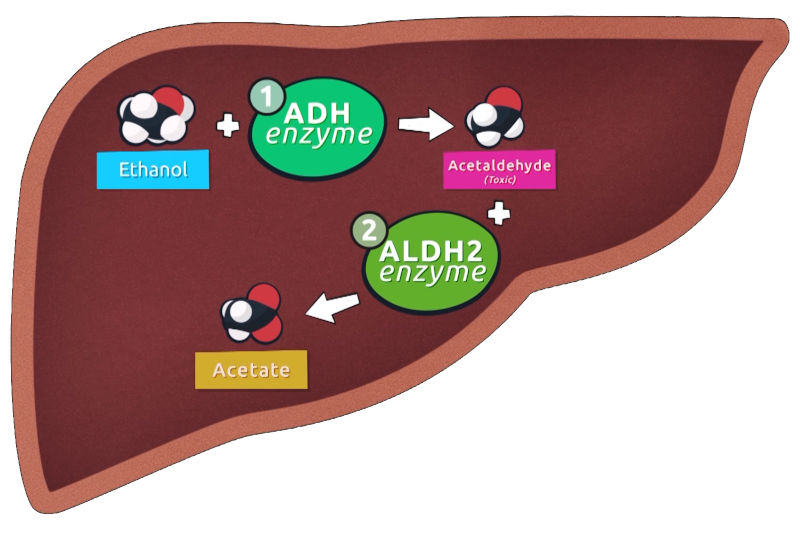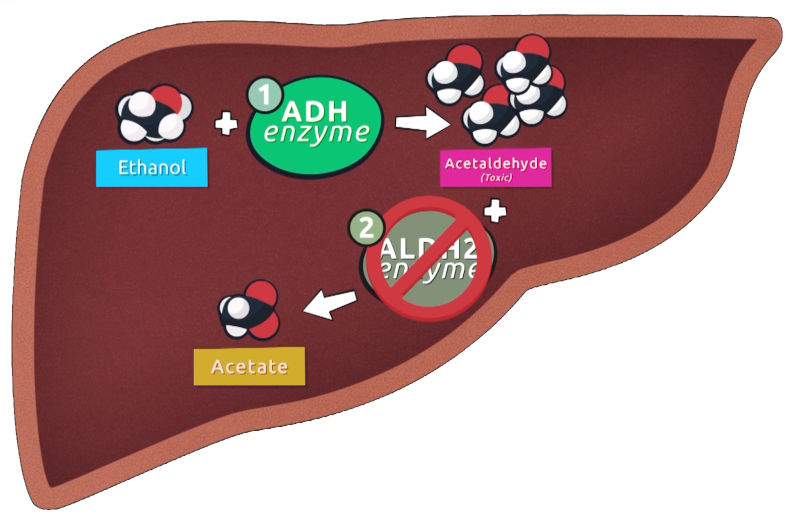
Many Australians with Asian flush are unaware that flushing red from alcohol can also signal that a person is in a higher risk category for various alcohol-related health issues. The purpose of this article is to discuss these risks and hopefully offer clarity about where they stand in terms of these risks as a person with Asian flush.
Table of Contents
- Long-Term Health Risks for Australians with Asian Flush?
- Alcohol Metabolism in People with Asian flush
- What is Acetaldehyde?
- Overall Increase in Alcohol-Related Risks
- Asian Flush Linked to Increased Cancer Risks
- Asian flush linked to DNA damage
- How to reduce risks
Long-Term Health Risks for Australians with Asian Flush
Yes, Australians with Asian flush should be aware of some specific health risks associated with alcohol consumption. The three most spoken about risks will be summarised below and then elaborated on later in the article:
It should come as no surprise that alcohol consumption, in general, comes with its own long-term health risks. However, people with Asian flush might be in a higher risk category.
“Those who have the condition but still drink heavily may be more vulnerable to health risks imposed by their alcohol consumption.”
James Marshall, PHD, Emeritus Professor from Department of Epidemiology and Environmental Health at University at Buffalo
According to Dr Marshall, the risks inherent in alcohol consumption might affect people with Asian flush more than others.
In addition to having a heightened risk to alcohol’s longer terms risks, Asian flush sufferers also face some specific Asian flush cancer risks.
“If you are Asian and drink alcohol frequently, you may have a higher risk of getting stomach or oesophageal cancer or peptic ulcers due to a genetic inability to efficiently process acetaldehyde, a toxic by-product of alcohol metabolism,”
Dr Tan Ek Khoon, Associate Consultant at the Department of Hepato-pancreato-biliary and Transplant Surgery, Singapore General Hospital.
Dr Khoon highlights some of the more concerning long-term risks facing people with Asian flush, linking them directly to an inability to process a toxic metabolite called acetaldehyde. We will discuss acetaldehyde and the metabolic process of alcohol later in this article.
Finally, there is also some evidence to believe that people with Asian flush may be more at risk of DNA damage from alcohol consumption.
According to a 2018 study in Nature, mice with the gene responsible for the Asian flush in humans showed four times more DNA damage after a single dose of alcohol than mice without the gene.
To understand why people with Asian flush may be in a higher risk category for various health risks such as cancer and DNA damage, it is necessary to look at how Asian flush sufferers metabolise alcohol differently than most people.
Alcohol Metabolism in People with Asian Flush
In an otherwise healthy liver, ethanol (alcohol) is converted into acetaldehyde by the ADH enzyme. Acetaldehyde is toxic for the body, so the ALDH2 enzyme quickly breaks it down into Acetate, which is essentially vinegar.

In the liver of someone with Asian flush, the process is different. People who get a red face from alcohol typically have a deficiency in the ALDH2 enzyme. This means that the liver is unable to break down the acetaldehyde into acetate. As a result, the toxin accumulates beyond tolerable levels and the body reacts with negative symptoms such as a red flushed face.

As we can see from the two diagrams, acetaldehyde is an integral catalyst to the Asian flush reaction.
What is Acetaldehyde?
Acetaldehyde is an organic chemical compound that occurs widely in nature and is produced on a large scale in industrial processes.
It commonly enters our body via the food we eat, the liquids with drink and the air we breath. As discussed above, it is also produced by the partial oxidation of alcohol by the liver.
Acetaldehyde is not only toxic and an irritant to many parts of the body, but it is also potentially carcinogenic. In October 2009 the International Agency for Research on Cancer released a report confirming acetaldehyde from alcohol to be a “Group I human carcinogen”.
Australians with Asian flush should be aware that when they consume alcohol, they are increasing the amount of acetaldehyde being produced in their liver.
As a result of not being able to break it down, this toxin finds its way into the body and begins to cause short terms symptoms (i.e. red face, headaches, etc) and the various longer-term complications alluded to above ad discussed in further detail below.
Overall Increase in Alcohol-Related Risks
Many of the health risks associated with alcohol consumption can be linked to prolonged exposure to acetaldehyde.
According to a fact sheet by the Centers for Disease Control and Prevention (CDC), excessive alcohol consumption can, over time, lead to the development of chronic diseases and other problems including:
- High blood pressure and heart disease.
- Stroke.
- Liver disease.
- Cancer of the breast, mouth, throat, oesophagus, liver, and colon.
- Learning and memory problems.
- Mental health problems, including depression and anxiety.
As mentioned, many of these problems are, wholly or in part, caused by exposure to acetaldehyde.
Therefore, Australians with Asian flush should be aware that they are exposed to more acetaldehyde from alcohol than regular drinkers.
Australians with Asian flush should not be shy to speak to their medical practitioner about the various risks of alcohol consumption and discuss ways to minimise acetaldehyde exposure.
Asian Flush Linked to Increased Cancer Risks
The United States National Institutes of Health and the International Agency for Research on Cancer have issued specific warnings for people with Asian flush about heightened cancer risks from alcohol consumption.
Both of these governmental warnings cite research conducted in 2009 that shows a link between ALDH2 enzyme deficiency and an increased risk of oesophageal cancer from alcohol consumption.
As discussed above, ALDH2 deficiency refers to the genetic enzyme deficiency that stops the body from properly metabolising alcohol and causes Asian flush.
If Australians with Asian flush choose to drink alcohol, they should be aware that they are putting more toxic acetaldehyde into their bodies than normal drinkers.
Many health authorities are cautioning people with Asian flush to examine their alcohol consumption and inform themselves about the various risks of this kind of acetaldehyde exposure.
All Australians with Asian flush should speak to their medical practitioner about what acetaldehyde is and how it can cause serious health risks for people who flush red from alcohol.
Asian Flush Linked to DNA Damage
According to more recent 2018 study in Nature, mice with the gene responsible for Asian flush in humans had four times the expected amount of DNA damage from a single dose of alcohol.
According to the lead researcher in the study:
If you carry the flushing mutation, alcohol could be very damaging to you.
Ketan Patel, a professor with the MRC Laboratory of Molecular Biology at Cambridge University
The study also observed the body’s reliance on its own repair system to repair the DNA damaged from alcohol consumption.
The lead researcher, Mr Patel, stressed that any DNA damage caused by alcohol would need to be completely repaired by the body itself.
If these results (applicable to mice) are shown to be applicable to humans, Australians with Asian flush should be conscious that they are incurring 4 times more DNA damage from every drink and asking4 times more effort from their body’s DNA repair system.
How to Reduce Risks
All Australians who get Asian flush after alcohol should speak to their medical practitioner and get the informed advice of someone who knows their personal situation intimately.
Long-term exposure to acetaldehyde is the main culprit behind most of the health risks facing people with Asian flush.
Acetaldehyde exposure can be reduced by refraining from drinking alcohol or, for heavy drinkers, simply drinking substantially less than normal.
In our article titled 7 Easy Ways to Prevent Asian Flush, we speak about some tried and tested ways commonly used to reduce exposure to acetaldehyde and prevent the Asian flush reaction.


Leave a Reply